TURKEY'S WHIRLING DERVISHES
At one with the Universe
By Chris McBeath
(
For Travel Writers Tales)
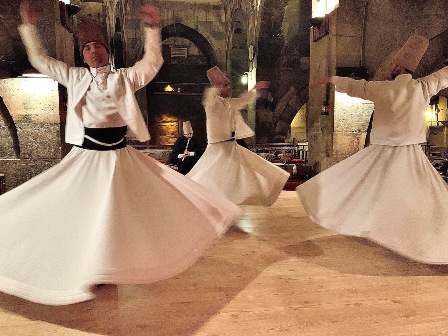
Whirling Dervishes Triad
(Photo: Chris McBeath)
The whirling dervishes have become such an iconic tourist commodity that visitors can see their mesmerizing meditations performed in train station halls, cultural centers, and even converted hammams (steam baths). For many camera-clicking enthusiasts, this will suffice but for those seeking its more spiritual essence, head for a dervish monastery (a tekke ) where the entire experience transforms into something quite magical.
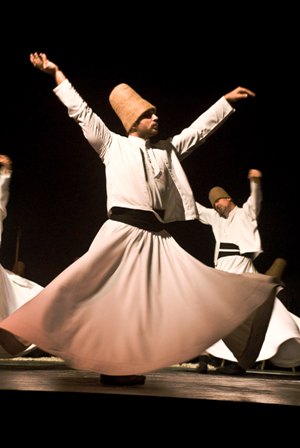
Whirling Dervishes in Motion (Photo: B. George)
The ceremony (known as a sema ) is a religious affair, started by Mevlana (Jalaluddin) Rumi, the 13 th century poet and mystic who chose dance and music as his path to God. From Konya in central Turkey where Rumi lived for much of his life and is buried, his Sufi followers founded the Mevlevi order and spread the dance throughout the Ottoman Empire. Over the next 700 years, it evolved into the entrancing practice you see today, filled with tradition and ritual.
The Cultural Heart Although there are tekkes in Istanbul and elsewhere, Konya is widely regarded as the cultural epicenter for whirling dervish. Here, regardless of whether there is an audience, devotions take place daily in the tekke of a former dervish seminary. The adjoining mausoleum (site of Rumi's tomb) houses manuscripts of Mevlana's works alongside various accouterments of the sect, and the entire complex hosts a 9-day dervish festival in December. For all these reasons, Konya offers one of the most authentic experiences in the country.
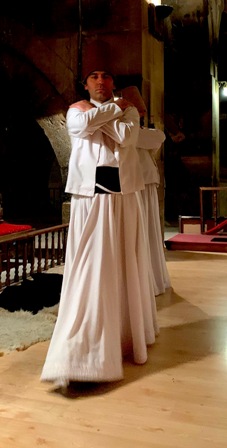
Honoring God as One:
Whirling Dervishes Preparation
(Photo: Chris McBeath)
What to Expect
Spectators sit in a semi circle around the dancers ( semazen ) in preparation to receive the lightness – the Nirvana – of the turning prayer. During the hour-long ceremony, distractions are minimal so the focus is palpable. There is no photography allowed (although they do whirl for camera-buffs afterwards); no cell phones; no applause; no young children; and no-one is permitted to enter or leave. If the dervishes succeed in helping spectators get in touch with their spirituality, then the dancer has succeeded in his worship.
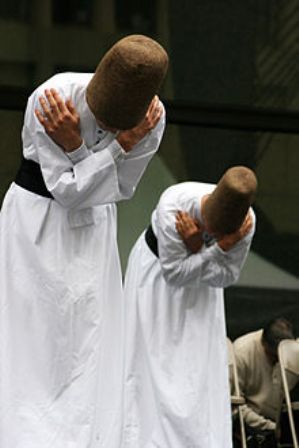 Bowing to Destiny: Preparing for Meditation (Photo: Tourism Turkey) |
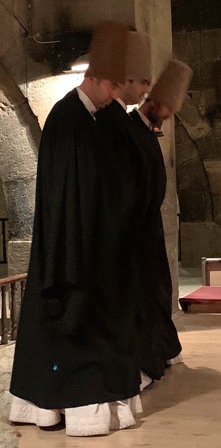 Cloaked Whirling Dervishes (Photo: Chris McBeath |
The Symbolism
The sema is divided into four parts involving music and melodic chanting, the dervish entrance and invocation, communion with destiny, and the whirling meditation itself. Clothing plays an important role. The camel-hair headdress (a sikke ) represents a tombstone of the ego – its color depending on the sect. The black cloak (a hirka ) embodies the wearers' worldly life and is cast off during the service. The white skirt (a tenure ) beneath represents a shroud of the ego which, when revealed, denotes a rebirth to perfection and signifies that the dancer is ready to start the captivating and complex whirls that define the practice.
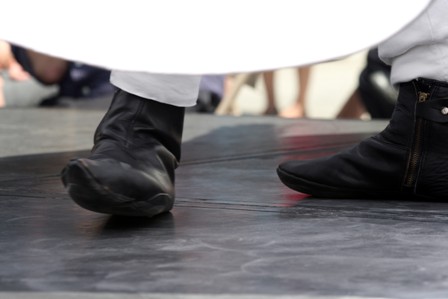
Dancers' Feet (Photo Q. Dombrowski)
The Movements
At the start, the dervish holds his arms crosswise over the heart, acknowledging God's unit as number one. As the spinning cycle (a dhikr ) commences, his arms lift and open – the right hand directed to the sky in readiness to receive God's beneficence and the left hand turning toward the earth denoting his willingness to convey God's spiritual gift to those in the audience.
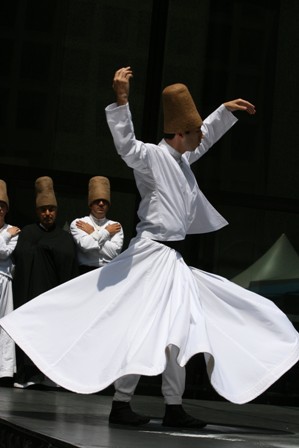
Whirling Dervishes Group
(Photo Q. Dombrowski)
The dancers, who fast for many hours before the sema, turn in rhythmic patterns, using the left foot to propel their bodies around the right food with their eyes open, but unfocused. The whirling seems orchestrated by a Grand Master who weaves in between their dancing rotations, all of which is fueled by music: usually an oud player – a wooden pear-shaped lute, a flute player that exudes a reedy, melancholic sound, and a kettle drummer.
The rotations, up to 30 per minute, are always counterclockwise, imitating the earth's rotation around the sun and recognizing that we are all one with the solar system. By revolving from right to left, it is believed that the dancer's heart is also embracing all humanity with love. Some have said that their tilting head mirrors the earth's axis but more practically it is one of the techniques used, alongside breathing strategies, to quell dizziness and feelings of nausea.
The Dervish Connection The whirling dervishes are everything you may have heard -- hypnotic, intriguing and mystic. Over the millennia, theirs is a religion that has evolved from many diverse cultures and has become a remarkable fusion of Christianity, Shamanism and Islam. To some, it is an unlikely union of faiths and philosophies, but bearing witness to their sacred prayer is to understand why the whirling dervishes continue to amaze, mesmerize and connect to so many people from different parts of the world.
_______________________
Travel Writers' Tales is an independent travel article syndicate that offers professionally written travel articles to newspaper editors and publishers. To check out more, visit www.travelwriterstales.com
PHOTOS: As attributed above.